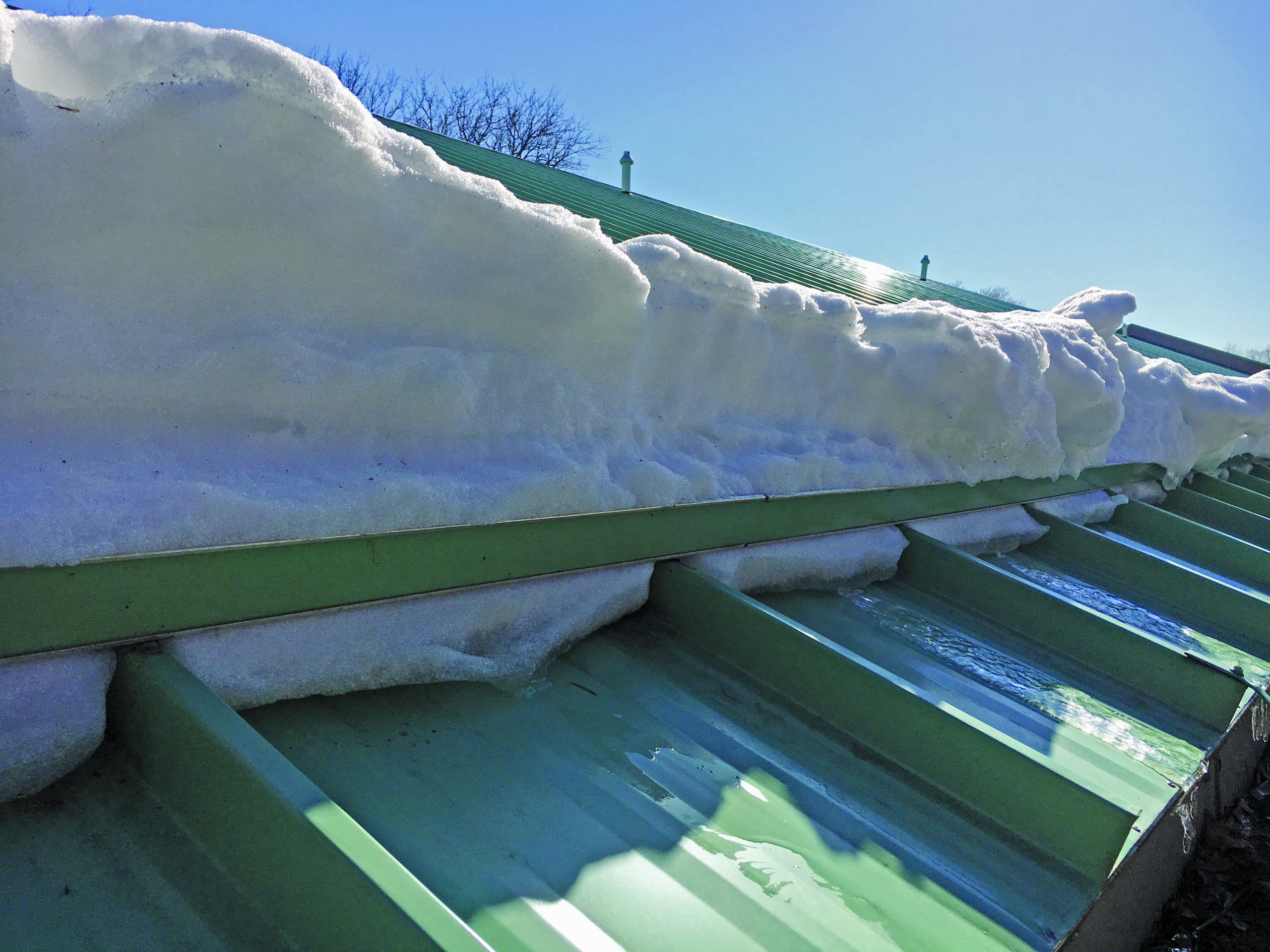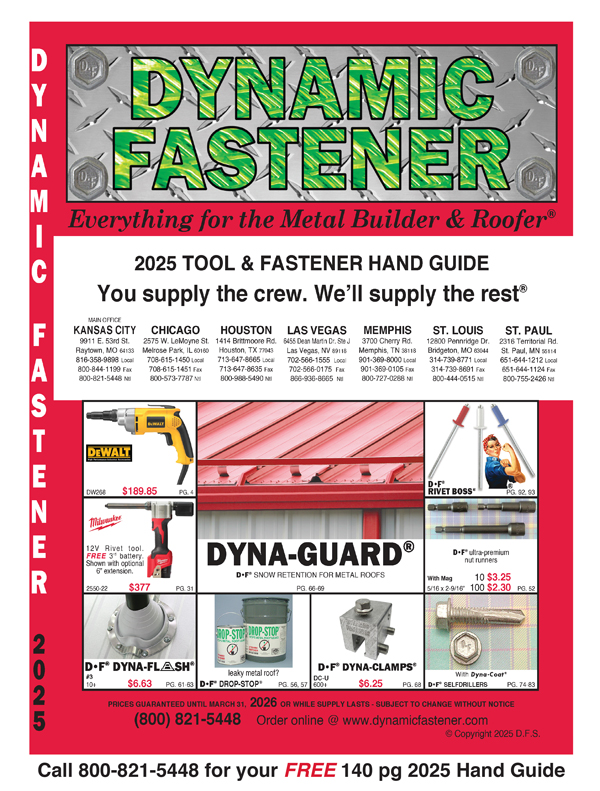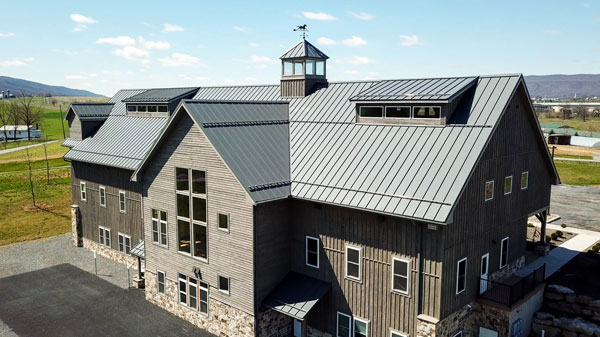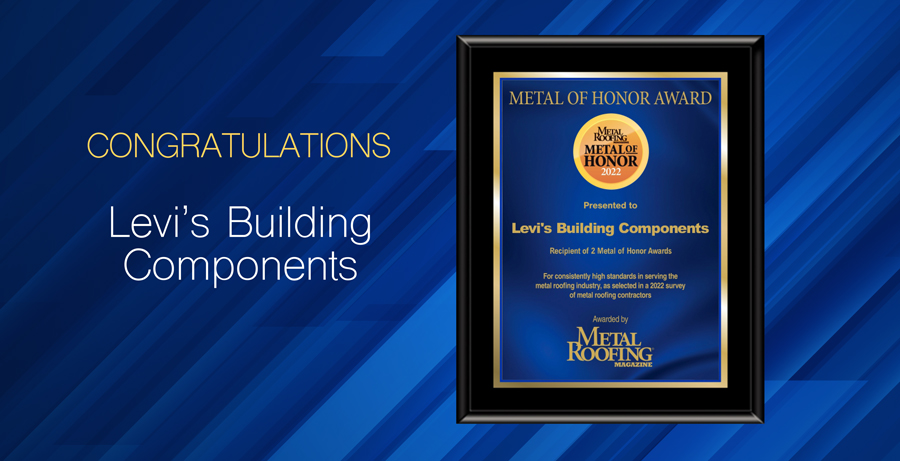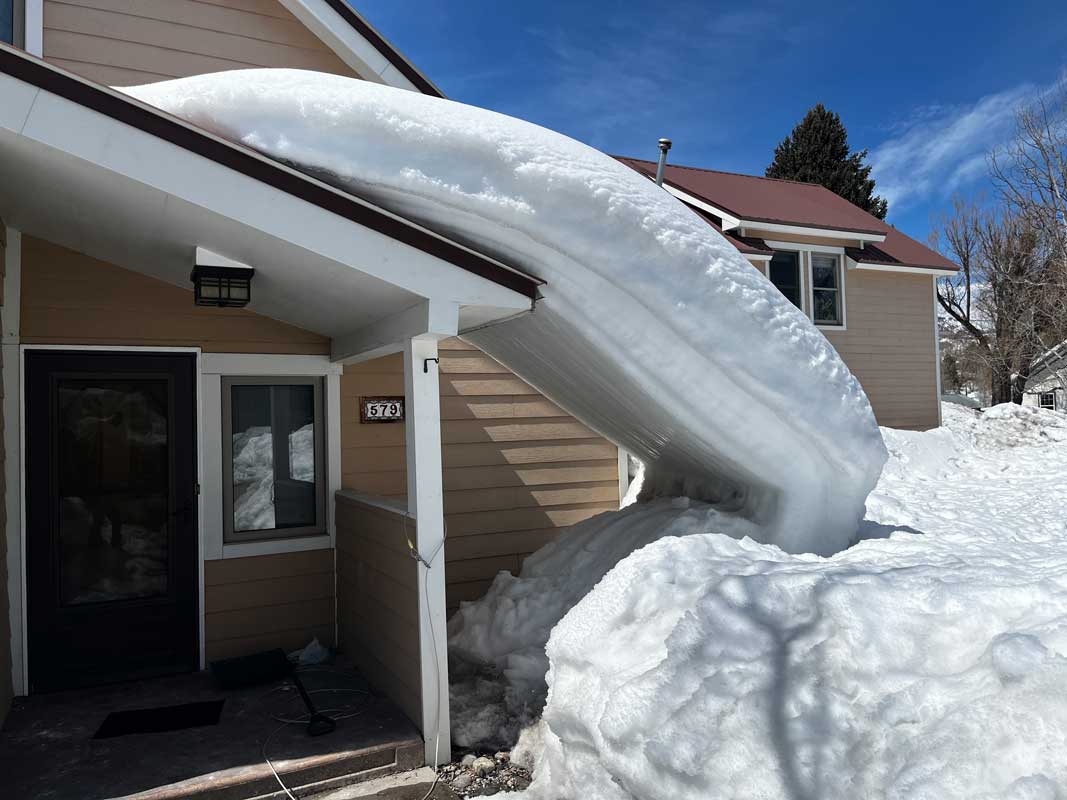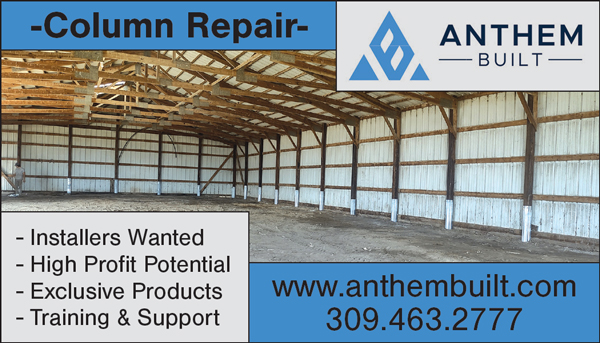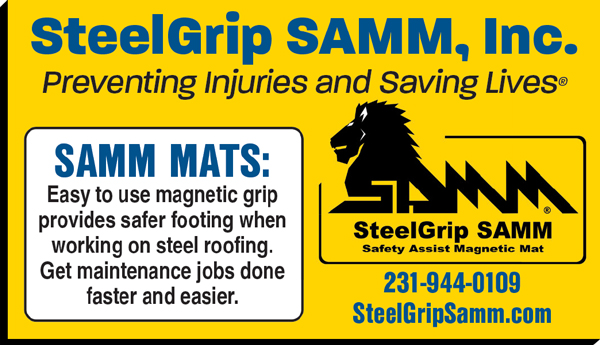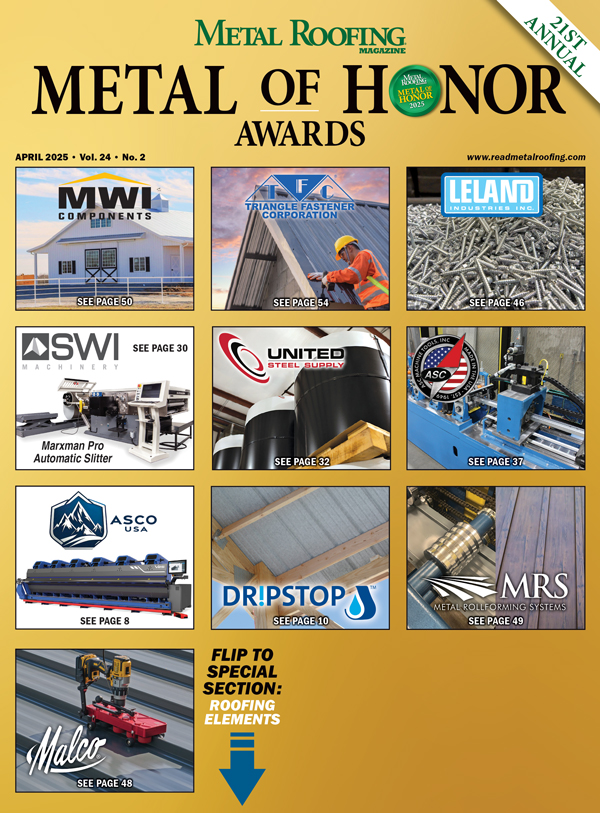By Rob Haddock, CEO and Founder of S-5! Metal Roof Innovations, Ltd
Year-after-year, rooftop avalanches cause hundreds of millions of dollars in property damage, personal injury, and even death. Snowpack can suddenly release and dump tons of snow below the eaves in a matter of seconds—endangering building elements, adjacent roofs, landscapes, vehicles, property, and, even worse, pedestrians. Inadequate snow guard systems (or none at all) create a life-safety issue and potential liability for building owners, designers, and contractors.
The best way to mitigate this avalanche danger on your metal roof and reduce liability caused by sliding snow and ice is by installing a scientifically tested and engineered snow retention system specific to the snow loads expected on your particular roof and metal roof profile.
A snow guard is a device or system that mechanically provides a frictional interface between the roof and the snow, so that snow evacuates the roof in a predictable and controlled fashion—evaporation (sublimation) and thaw rather than by a sudden and dangerous rooftop avalanche.
Before you can determine the best snow guard system for your metal rooftop, a number of considerations should be taken into account:
Understand what causes rooftop avalanches;
Know the math and science that goes into calculating service loads;
Consider the design of the snow retention system for your roof profile;
Weigh your options; and
Vet the snow retention system and its manufacturer/vendor’s qualifications.
Let’s Begin With…What Causes
a Rooftop Avalanche?
During snowfall, sunlight is occluded and snowpack is retained on the roof by two bonds between the snow blanket and the metal roof panels. The first is a very strong temperature-sensitive adhesive bond between the blanket of snow and the roof. The second is a cohesive bond at the upper ridge, where snowpack on one plane of the roof meets snowpack on the other (see above). The bonding effect adds a vertical load to the roof surface, which translates to a vector load parallel to the panels’ surface, often referred to as the “drag load” or “gravity load”—the weight/force of snow trying to slide off the roof. When vector forces exceed the strength of the two bonds, a rooftop avalanche occurs.

When a snowstorm passes, infrared rays from the sun pass through the translucent snowpack, warming the roof below and freeing the temperature-sensitive bond, while the interface is being lubricated by melt-water.
The vector force of the snow blanket is now resisted only by the cohesive bond at the upper ridge. The force exceeds the cohesive bond’s strength, and the blanket of snow splits at the ridge, causing a sudden release of snow from the roof. This can happen on one side of the ridge or both simultaneously, depending upon orientation of each to the sun
.
Understanding the Math and Science—
Calculating the Service Load
Now that we have covered what causes rooftop avalanches, let’s quantify the forces of snow on your rooftop. They can be mathematically calculated…and should be for any snow guard system.

The service loads applied to a snow guard system are a relatively simple calculation that varies with site specifics, all of which should be known to the design team:
the design roof snow load,
roof slope, and
roof length (eave-to-ridge)
These three factors determine the vector force that a system must resist for any roof surface and should be included in plans and specifications requiring an engineered system.
Vector force: The vertical weight of snow is reduced by the sine of the roof angle to arrive at the vector force parallel to the roof surface that acts on a snow guard. To calculate this force, multiply the vertical load (psf) by the sine of the roof angle. The loads for the entire length of each roof panel from eave to ridge are tributary to the snow guard(s) restraining it. That tributary force is determined by multiplying vector force (in psf) by the roof length (in feet) and the panel width (in feet) (see below left).

A number of factors should be considered when calculating this force acting upon the snow guard system:
The roof design snow load (not ground snow) should be used in these calculations. The roof snow (vertical) load is usually reduced from ground snow by some factor, but it may also be increased depending on project-specific variables. These variables are all dictated by engineering standards.
Caution should be exercised when roof and wall geometries create aerodynamic shade, resulting in drift loads on roof areas. This occurs on roofs adjacent to parapet or other wall conditions that extend above lower rooflines. Such conditions may increase roof loads significantly (see right). When a lower roof has a roof above not protected by snow guards, the discharge of sliding snow can also cause increased loading (and impact factors) to the lower roof.
A determination must also be made with respect to using uniform or non-uniform loads in design. Building codes should be consulted and appropriate engineering standards and calculations used to determine the actual in-service roof loads in all cases.
The vector force experienced by the snow guard system is reduced by the coefficient of friction between the roof material and snowbank. This coefficient can be substantial for some materials but is almost nonexistent for metal. For this reason, it is not utilized in calculation on metal roofs.
Matching Product Limitations to the Service Load: Factors of safety (FS) are used when designing a connection based on the tested failure load of any attachment. “Ultimate” load is the point at which failure occurs by system testing. “Allowable” load is the load used in design to ensure that doesn’t happen in service. The appropriate FS is subject to designer/engineer discretion. The Metal Construction Association (MCA) recommends an FS no less than 2.0 for mechanically attached snow guards.
The designer should be aware of and consider the repetition, credibility, and validity of any testing of snow guard products to determine the frequency of placement and expected performance life (which should be equivalent to the roof life). After determining the service loads to be resisted and matching them to the snow retention system, it is important to determine population and placement for your specific metal roof.
Snow Retention System Design Considerations
Snow Retention Population and Placement: Snowbanks typically accumulate and densify in a cross-sectional wedge pattern. All snow guards rely on the snow’s own compressive strength to restrain its movement. Gravitational forces compress the snowbank the most at its interface with the roof surface, especially toward its lower (eave) end—so this is where compressive strength is greatest (see below). The interface of snow retention devices at this location has proven to be strongly preferred worldwide and considered to be most effective. Because the compressive strength is so great at the base of the snowbank, snow guard devices only a few inches in height have proven to be successful, even when snowbanks are many feet deep.

System Design: Two snow guard system designs are quite common. One utilizes continuous horizontal components, assembled laterally across the roof in the style of a “fence.” Such assemblies are usually installed at or near the eaves. Depending on specific job conditions and load-to-failure characteristics of the devices, they may also be repeated in parallel rows up the slope of the roof, but with greater concentration near the eave area.
The other design consists of small, discontinuous individual units used as “cleats,” generally spot-located at or near the eave or repeated in a pattern progressing up the slope of the roof, again with a greater concentration near the eaves. This style also relies upon the shear strength within a snow bank to “bridge” between the individual units.
Both styles of snow guards (fence and cleat) have demonstrated satisfactory performance when tested, engineered, and installed properly and adequately.

Additional Considerations: Aside from adequate testing for holding capacity, other design considerations include verifying metals’ compatibility, matching corrosion resistance of the device with that of the panel material, and color matching.
Devices that utilize air-dried paints to match the color of roof panels may provide a perfect match initially, but a poor match after weathering a few years. This is due to inferior characteristics of air-dried paints when compared to the factory applied finishes of metal panels. Powder coating may provide greater longevity in terms of color stability, but generally is not equal to factory-applied PVDF panel finishes. The objective is serviceability that lasts as long as the roof.
Snow Retention Techniques
Next, let’s review the three techniques for mounting snow retention systems to a metal roof.
Two techniques use mechanically-attached snow guards. The distinction between the two involves clamping, which grips the standing seam in some fashion without actually puncturing the panel material (non-penetrating), versus fastening screws through the roof material (penetrating) into the structure. The third uses a chemically-attached “stick-on” adhesion method, which involves gluing individual snow guards to a roof surface.
Clamping a Snow Guard to a Standing Seam Type Roof: This method uses a seam-clamping attachment, and is a measurably secure option for a standing seam metal roof profile. Clamps attach directly to the roof seam using setscrews that do not penetrate the roof (mechanically-attached).
At S-5!, our clamping products use polished, round-point setscrews that compress the seam material against the opposite wall of the clamp—dimpling the material, but not penetrating it—and without coating damage (see top of following page). Clamp-to-seam attachments can easily be mounted after the roof has been installed and will not fatigue due to thermal heating or cooling of the roof. These measures prevent potentially voiding the warranties of a long-life, premium roof.
What You Can Expect With Clamp Mounted Attachments: With this method, the sliding force of the snow is transferred to the clamp and then into the roof panels. These loads vary from job to job. The holding strength of such a system should be quantified through rigorous testing and proven to resist the loads on any given job. At S-5!, we have tested and re-tested our clamps with almost every metal roof profile (more than 500 of them). You can view these results at www.s-5.com under the “Load Test Results” tab.

Attaching to the Building Structure Itself: The second method for mounting snow retention is a system that attaches snow guards through the roof and into the building structure (also a mechanical-attachment). Attaching to the building structure provides a secure and reliable method if properly tested, designed, installed, and waterproofed (see below left). It is only suitable for a roof that is attached the same way (i.e. with screws that penetrate the roof’s surface, attaching it to the structure).
What You Can Expect With Structure Attachments: Snow guards that attach directly to the structure, require penetration for anchorage of snow guard brackets. With these devices, weatherproofing for the long-term service life of the roof is of paramount importance, or you run the risk of leaks. Such waterproofing requires a high degree of expertise in part design, sealant chemistry, selection/sourcing, etc.
With S-5! components, we eliminate the guesswork by providing a state-of-the-art system with factory-applied sealants—designed to last the life of the roof—including protection from UV exposure and over-compression of the seal. We test for leak-free performance in accordance to ASTM E 2140.
The strength of the structural attachment mounting method is also important and should be proven and matched to the in-service loads to which the snow guard will be exposed. S-5! provides web-based tools, enabling you to calculate your service loads quickly and easily. And, these proven holding strengths determine snow guard population to the specifics of your project scientifically—not by guesswork.

Using a Stick-On Guard: The third type of snow retention is a stick-on (adhered) part (chemical-attachment). Some variations employ a factory-applied adhesive and others a field-applied one. At a glance, stick-on snow guard systems appear to be a very convenient and a lower cost option, but they are only lower in cost when you consider part costs versus total project costs, including labor and quantities required to do the job. Moreover, the replacement costs over the life of the roof are extensive.
This is not “if,” but “when” the adhesive diminishes in holding strength. Adhesives all diminish in holding strength, beginning with the first day of exposure. Replacement time is often relatively soon after installation, depending on orientation to the sun and other environmental factors (see below).
What You Can Expect With Chemically-Attached, Stick-On Mounted Attachments: Installation is simple enough. These parts attach directly to the roof with a glued application. But, if you look closely at the detailed instructions, installation becomes a bit more complicated—careful surface preparation is required, as well as many days of curing time for some at specific temperatures. (Suddenly, this is not as simple as it first seemed.)
When installed, stick-on snow guards typically have the lowest holding strength (which continues to diminish with age). When they fail, they can rip away paint coatings, leading to corrosion (see below). They also have the shortest lifespan due to the glue and/or plastic parts being unable to handle the harsh elements and total exposure expected on many roofs (i.e., UV, moisture, and temperature change, etc.).
How to Choose the Best Snow Retention
System for Your Project
Numerous snow guard vendors have appeared in the market, each claiming to be the best, ultimate, first, or strongest. Understand, there are no industry standards or mandates for design, manufacture, use, or testing of snow guards—no “snow guard police”—this market space is completely unregulated! So, it is a “buyer beware” scenario as to the appropriateness and proof of testing and engineering performed by the vendor.
How do you discern prudent product selection from sales rhetoric? In addition to understanding the art and science behind snow retention systems, most importantly, you should vet the manufacturer and its product offerings.
Vet and Specify: Manufacturer transparency is requisite to adequately vet a snow guard system. A vendor who lauds the capabilities of his system but fails to provide proof of those claims may be blowing smoke. The designer should scrutinize manufacturer qualifications/certifications to ensure a safe, engineered application and long-term service. This transparency should extend from raw material sourcing through manufacture and product hand-off. Scrutiny of vendor’s evidence provides credibility and assurance to the buyer. A qualified manufacturer should gladly provide proof of claims.
Proof of Testing: Anchorage of clamps to the roof specimen should be repetitiously tested on the specific material, gauge, and roof profile. A minimum of three test repetitions should be conducted (fewer are not a scientifically acceptable statistical average). Testing of all system components should be conducted by a third-party ISO 17025-accredited lab and specific to the exact roof and brand of manufacture used on the project.
It is also not scientifically acceptable to apply a test result from one set of test specimens to another similar-style roof product. Request test reports from the vendor, proving anchorage values of the appropriate testing used in engineering calculations. Ideally, panel-specific test results should be available to you and published on the vendor’s website.
Proof of Engineering: Project-specific engineering should be provided by the vendor and incorporate the tested strength of the system with an appropriate factor of safety applied. Insist that calculations are provided prior to product selection. Ideally, the vendor should offer a web-based calculator with real-time output showing calculations and allowable loads specific to your project, including product names of snow guard systems and specific brand of roof manufacturer (see below). At a minimum, require these calculations with submittals. Better yet, why not have the vendor provide them stamped by a registered Professional Engineer?
Proof of Certified Manufacturing: How can you know the product tested is truly the product purchased? Systems may look the same, but alloys, tensile strength, yield, and other mechanical properties should be verified through certified manufacturing with third-party audits in an ISO 9001-15-compliant facility, not because one looks the same as the other. Ask to see the current ISO Certificate (see top of following page). Ideally, it should be displayed on the vendor’s website.
Warranties: Does the manufacturer offer meaningful product defect and performance warranties? Obtain copies prior to purchase—and read the fine print! Ideally, they should be displayed on the vendor’s website. Will the vendor be in business for the long-term to honor them if needed? Has the vendor substantiated its track record? How long the company has been in business is irrelevant. The question is, “How long and on how many projects has the system you are buying been in use?”
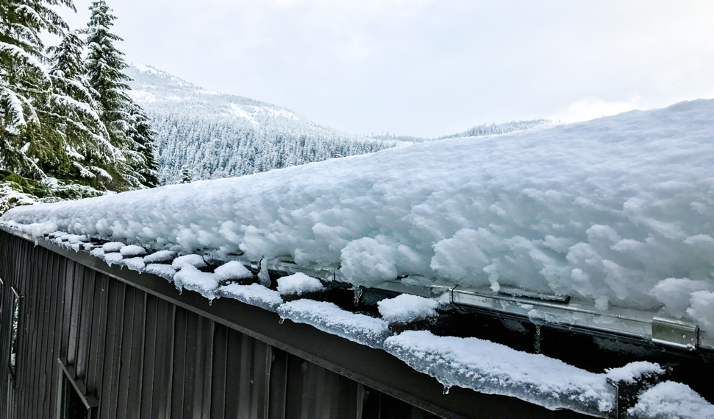
Why Use
Snow Retention?
Metal roofs are known for their durability, sustainability and versatility. However, metal roofs are slippery and can pose potential of rooftop avalanches in the discharge areas below the eaves, causing property damage, personal injury, and even death.
A scientifically tested and engineered snow retention system mechanically increases the friction between the roof and the snow, so the buildup of snow and ice on a roof evacuates in a predictable and controlled fashion rather than by a sudden release of sliding snow.
To determine the best snow guard system for your metal roof, you should understand the art and science behind snow retention systems, and most importantly, vet the manufacturer and its product offerings.
A smart and rather low-cost investment in a snow retention system specific to your metal roof profile not only protects the roof and roof elements, but protects the rest of the building and its occupants in addition to pedestrians, vehicles, equipment, and landscaping below. It reduces short-term and long-term maintenance costs and most of all, reduces potential liability for building owners, designers, and contractors.
Rob Haddock, the inventor of S-5! attachment technology, is a former contractor, an award-winning roof-forensics expert, author, lecturer, and building envelope scientist. He has worked in various aspects of metal roofing for nearly five decades.
For more information, videos, and webinars on the topic of snow retention systems and more, visit S-5!’s website at www.s-5.com or the Metal Construction Association’s (MCA) website at www.metalcon struction.org. MR



